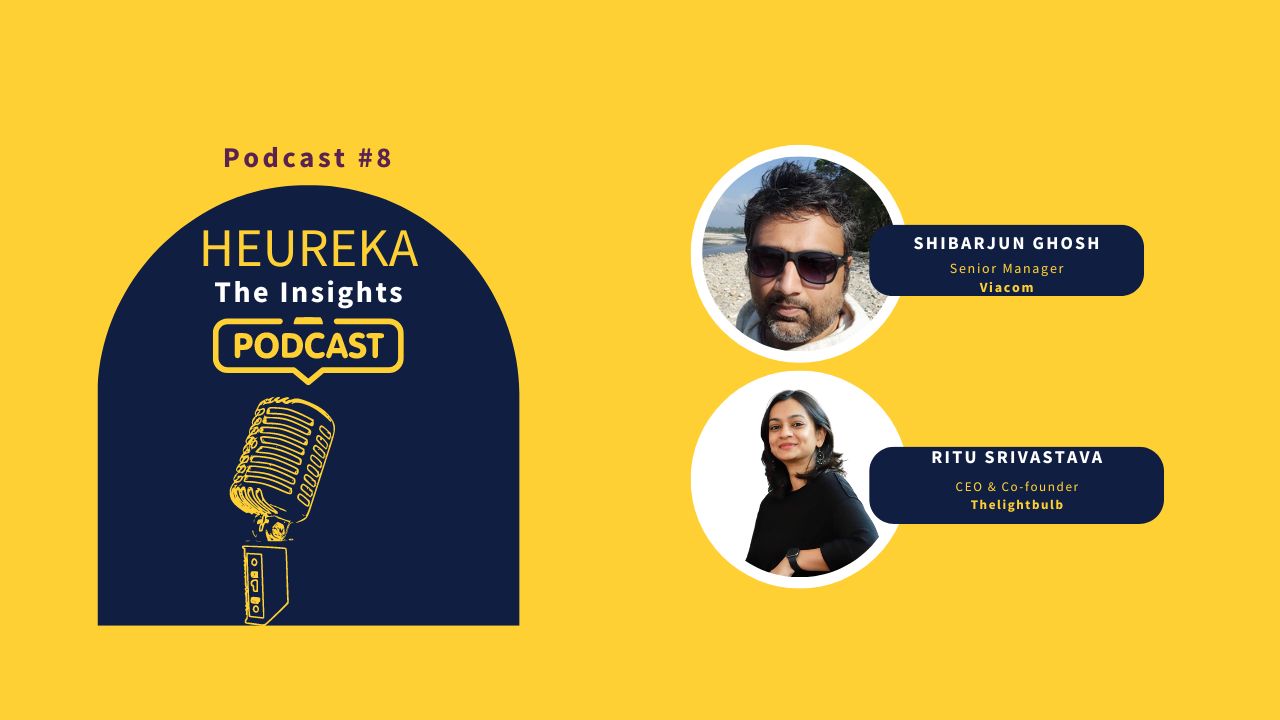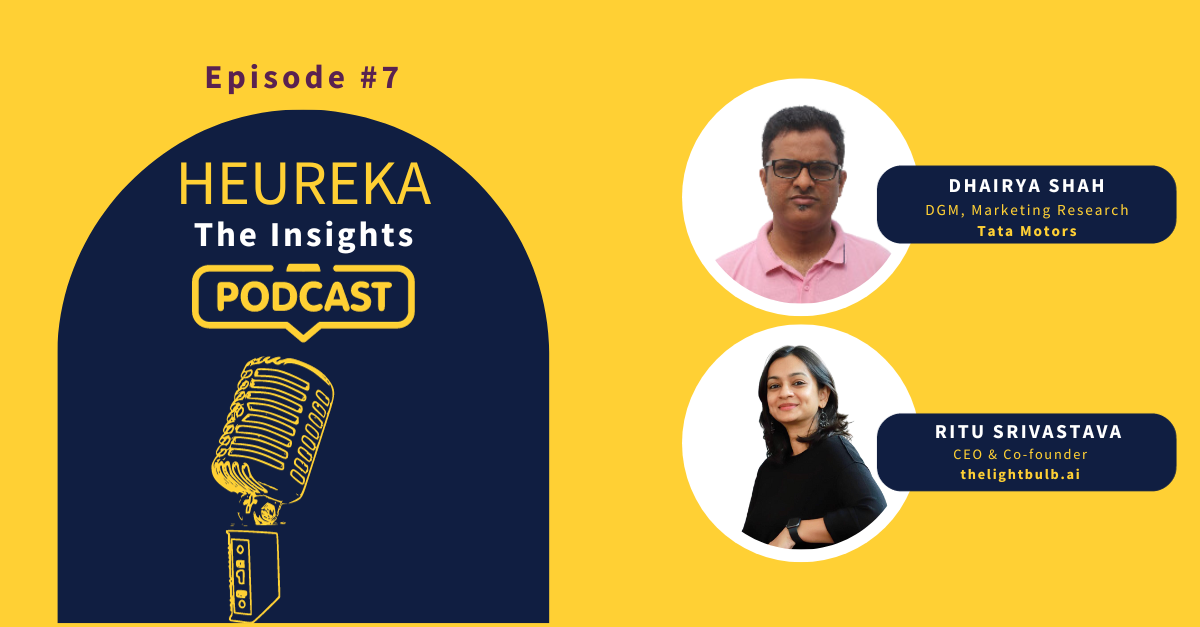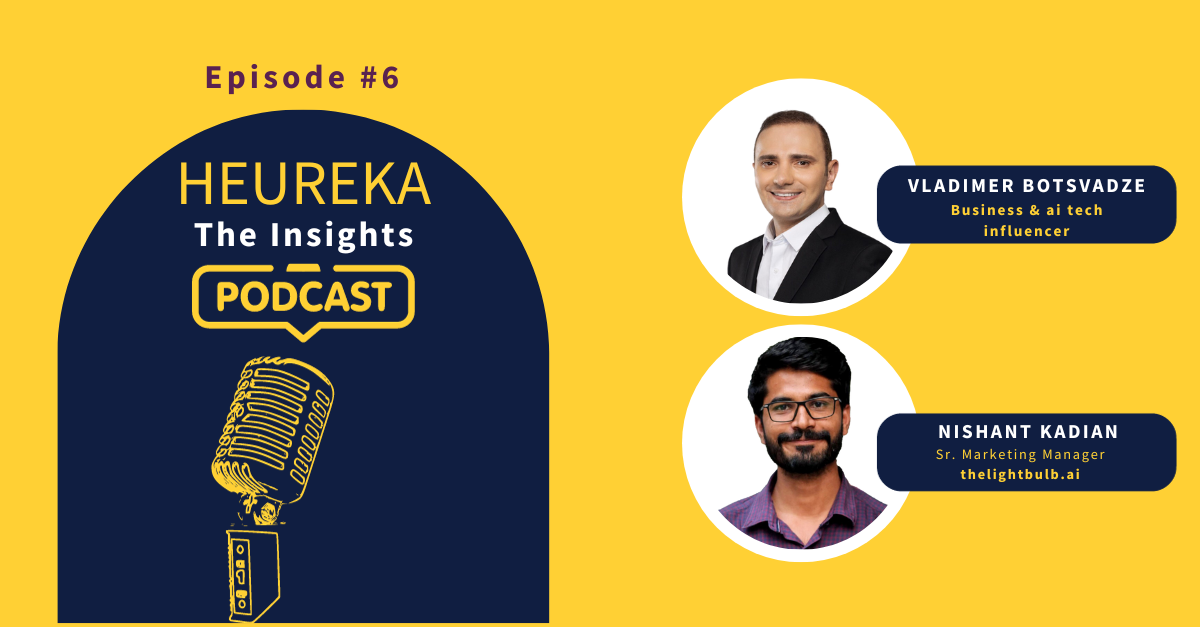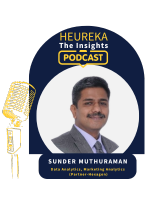Ep #9 – Sunder Muthuraman on the changing face of the Insights Industry
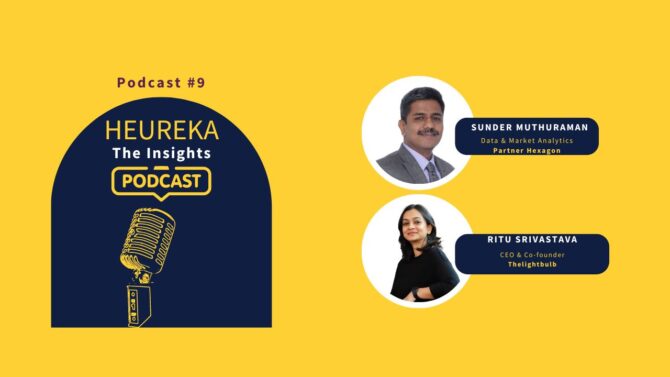
Ep #9 – Sunder Muthuraman on the changing face of the Insights Industry
The 9th episode of ‘Heureka – The Insights podcast’ by thelightbulb.ai.
Welcome to Sunder Muthuraman’s profile! Sunder is a seasoned professional in Data and Marketing Analytics, currently a Partner at Hexagon in India. With leadership roles at Kantar and Gain Theory, Sunder has shaped analytics strategies across the Asia-Pacific region. Explore Sunder’s profile to discover his extensive expertise in consumer insights and marketing analytics.
Guest: Sunder Muthuraman
Sunder Muthuraman is an accomplished professional specializing in Data Analytics and Marketing Analytics, with a wealth of experience across various roles and organizations. Currently a Partner at Hexagon, Sunder contributes to Marketing Analytics, Market Research, Data Analytics, and Strategy initiatives in India.
Prior to his role at Hexagon, Sunder held leadership positions at renowned firms. He was the CEO (APAC) and Global Chief Client Officer – Analytics Practice at Kantar, where he played a pivotal role in shaping analytics strategies across the Asia-Pacific region. Before Kantar, Sunder served as CSO Worldwide and CEO APAC at Gain Theory, based in Bengaluru, India. Additionally, he held the position of Managing Partner at Meritus Analytics for several years.
Earlier in his career, Sunder gained valuable experience in consumer insights, marketing analytics, and media strategy through leadership roles at GroupM, Mindshare, and Ogilvy & Mather.
Sunder Muthuraman’s extensive expertise and leadership in the field of analytics have been instrumental in driving innovation and growth within the industry. He continues to make significant contributions to the field of Data and Marketing Analytics.
Host: Ritu Soni Srivastava
Heureka – The Insights Podcast is a series of podcast episodes hosted by Ritu Soni Srivastava, who is a seasoned entrepreneur, focused on her current startup thelightbulb.ai, a full-stack emotion ai platform for digital interactions that has scanned more than 8 million faces for emotion analysis. She has held pivotal profiles across deep-tech, health-tech, telecom and media companies over the last 20 years. Her cross-industries experience gives her a unique edge in understanding consumer trends and insights across verticals.
In the podcast, Shibarjun shares some interesting experiences, challenges and solutions of working from agency as well as brand side.
Engagement and Sentiment Analysis of Podcast
Note: Engagement and sentiment analysis are generated using thelightbulb.ai’s Insights Pro

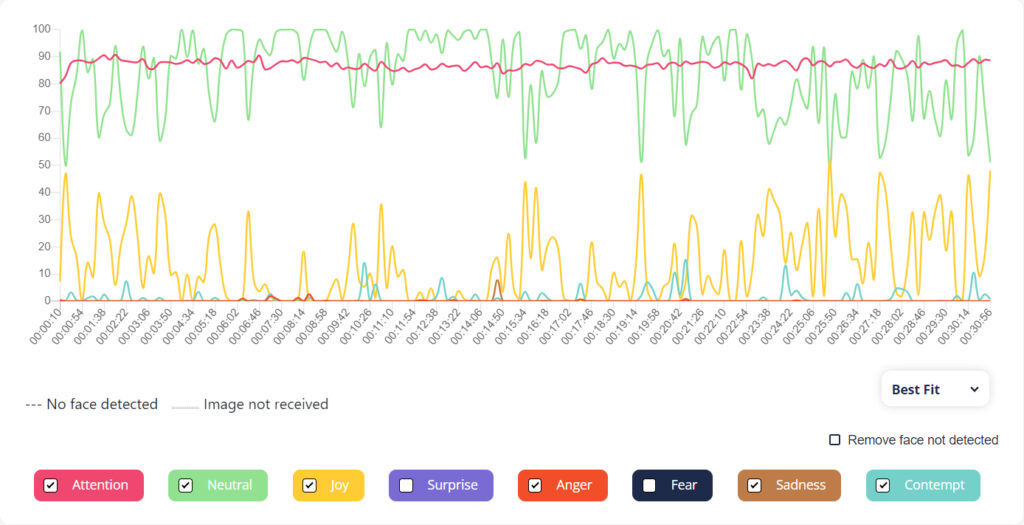
Voice Transcripts of Podcast
Note: Transcription of the podcast is generated using thelightbulb.ai’s Insights Pro
Heureka by thelightbulb.ai, The Insights podcast.
Ritu Soni Srivastava: Hi, everybody, and welcome to the I don’t know which episode of Hureka, the Insights podcast, because we’re finally, getting near the double digit numbers. And today, we have a guest with us who was one of our earliest acquaintances in the space of market research and instrumental to us debuting at the MRSI. We have with us today, Sunder Muthuraman. He is essentially an analytics person, and that has manifested in his multiple roles that he’s held over the years. One of the most prominent for me being his global chief client officer of the analytics practice role at Kantar, but he’s also been with Game Theory.
Ritu Soni Srivastava: He’s been with Meritus Analytics. He’s been with GroupM, and now he’s self employed, and essentially lending his expertise in analytics across multiple organizations, both in India, Southeast Asia, and in many other areas. So, Nair, please do introduce yourself to our viewers and do tell them a little bit about how you came to be where you are today and, walk us through your journey so far.
Sunder Muthuraman: Thanks for the introduction, Ritu. I mean, you know, just before you started the recording, you said I worked for a very long time, which, definitely seems that way. So just briefly, I started off in the advertising, media planning, context, and community. And, it always intrigued and interested me to figure out why we are spending some so much money, what is the kind of impact, that a brand achieves. And and these are the questions that led me to, work with teams within the organizations that the first organization you mentioned, I don’t think you mentioned that it’s Ogilvy.
Sunder Muthuraman: So there were a bunch of people who were always thinking tinkering around and asking these questions. So that’s how I got introduced into the analytics space. So that led to, you know, creating and forming teams, that primarily focused on answering these questions. And then that perhaps is a much longer journey in a career sense as against advertising, you know, answering questions with analytics. So that’s really the brief introduction.
Sunder Muthuraman: You know, the idea was and continues to be to help customers make sense of data and make it useful for their business decisions.
Ritu Soni Srivastava: I think that’s a beautiful summation of the roles that you’ve played in your different organizations. But, you know, at the risk of sounding a little offensive, the typical view of analytics is that it’s boring. But I’m assuming since you’ve spent almost 30 years in it, there is something very, very exciting about finding out how pieces of different puzzles interact together and how the impact of one has an impact on the other. Tell me what you find most exciting about your play in analytics. What really wakes you up when you go to work?
Ritu Soni Srivastava: Why what is your reason for go to going to work in analytics?
Sunder Muthuraman: I think, I mean, I guess you want to provoke and say boring. Work sometimes it is. Most workspaces, you know, in respect of what you do tends to be 80% of the same and 20%, you know, of new things or exciting things that you want to change and drive. Like, that’s if it wasn’t the case, then, nobody would have a business. You know, you can’t keep discovering new things every day.
Sunder Muthuraman: I think the, but that said, you know, at least, I’m thankful, and I’ve perhaps been part of analytics at a time when things, whether I liked it or not, changed every 2, 3 years. So it at some time, it is the context of available data At, you know, some other times, it has been how you analyze the data. And, then there has been a whole, context of how you report information and data and how people can interact with it. You know, there’s a whole bunch of technologies that came by. And, if you couldn’t do anything there, then you perhaps didn’t have a plain analytics space.
Sunder Muthuraman: Right? And the same thing happened with the tools that you use for analytics. There was a time where there were monolithic, very large players, where you paid a lot of money to just subscribe to a platform that could help you do the analytics. And then, you know, the whole, open era happened. So open source, analytical tools appeared.
Sunder Muthuraman: So I think the exciting part of you may, is, the pace of change that happened in this space. It’s not change for changes sake and the and, you know, what it enabled us to do. I think that really is, what I would say, what gets me to continue to be in this space and say, you know, ask a tech and say, you know, what should I do next? I think that really is the key and or like yourself, for example, you know, you were trying to use current technology, which is, machine learning. You know, give it whatever name that you want, Quality AI, perhaps we are not there yet truly.
Sunder Muthuraman: But I think, it’s, transformative again. You know, things that took perhaps ages. I mean, if not, I mean, ages is a very, you know, open time frame. But let’s say what took weeks now takes day. And what you could never do, you can do today.
Sunder Muthuraman Right? So I think that really is the exciting part. And analytics, if viewed with the lens of saying how do we enable, data flow information to, get us to a point where we can actually use it to make decisions, you know, without getting into, I mean, the user. I mean, if you if you if you okay. Let me rephrase.
Sunder Muthuraman: Right? If you look off the ecosystem, there is data and there is somebody who has to somebody or some system that has to analyze that information and then there is an end user. Right? I think the opportunity always has been to make sure that the end user, with the least friction, least amount of time, least effort, gets to a point where he or she can make use of that insight from that data. Right?
Sunder Muthuraman: So I think that, really is the key. And if you can do that, obviously, you’ll have a business. Obviously, you will, be able to grow very well. Right? I think that is, you know, in another way what excites me about this place.
Ritu Soni Srivastava: Lovely. Tell me one thing. The one of the common misconceptions about the market research industry is that it’s though it’s a massive industry, not just in terms of scale, but, you know, globally, geographically, in any way that counts, the impression of it is that it’s still fairly traditional and very services oriented in nature. Would you agree with that view, or is the penetration of tools and technology significantly in the last decade? Has it changed the way research is conducted, or are we still waiting for that tipping point into the usage of, technology?
Sunder Muthuraman: Yep. I think I see it very differently. It’s not the industry per se. Right? Because when you say the industry, then you’re trying to kind of, put things in a box and say, you know, all these belong to this industry.
Sunder Muthuraman: Right? But if you look at us, you know, if you say insights as an industry, I think MR to me is a subset of that. Now if you say, you know, MR was, you know, traditionally looked at as people who enable data collection and summarization and some analytics and family types of delivery, then I think, we are really taking a narrow view. So so if you say if you use the word traditional, if it was about data collection using whatever forms and instruments, then perhaps you’re right. Right?
Sunder Muthuraman: But even there, if you say things haven’t changed, I would disagree. Right? Because the method of data collection moved from pen and paper to, you know, touch screens and, you know, like, but has before that using telephones. So I think change is constant. I think the ability to adapt and, use those tools and technologies available to you at different point in time as an organization is different.
Sunder Muthuraman: So some organizations do it fast, some organizations take time, and then there are some, you know, who are, you know, obviously disrupting people who are not wanting to change. So I think this is a constant wherever you go. So I I I wouldn’t want to say, you know, MR is traditional, but I think, you know, what I would, you know, perhaps, you know, call it out as a context where there has been a constant redefinition of what insights and insights delivery mean. And if you encompass the ecosystem that’s doing that, I don’t think it’s traditional at all. I mean, you know, you know, be it, you guys at Lightbulb or several others, have always been, you know, wanting to disrupt and change.
Sunder Muthuraman: And, you know, it’s not proven to do from doing it and saying, oh, no. No. I’m not as traditional. I don’t want to do it. Like, you see the opportunity, you think change can happen, and, obviously, you know, change happens in in small specific areas, and then, you know, it’s a spark that kind of, builds up and becomes, you know, the leading light across organization.
Sunder Muthuraman: So I think that’s really what it is. So, yes, you know, if somebody you encounter is taking time to change, it’s just that. You know, it’s, and that’s also sometimes if it’s a business, it is also dependent on what your business was. Now you can’t overnight say, you know, if you are in the railway business since overnight, you can’t say, you know, I’m in the business of moving passengers and say from tomorrow, I’ll stop the trains, and I’ll start flying people. So that is part of the reason.
Sunder Muthuraman: So there are businesses that take time to change because that’s how their business is structured and that’s how the organization is defined, and that change will take time. That’s really how I put it.
Ritu Soni Srivastava: Absolutely. I think you answered, Bashi, the next question I had in mind, which was about what you feel is the most commonly misunderstood aspect or thing about the insights of the research industry? And I think you’ve pretty much answered that, but is there anything else that comes to mind when you meet people from outside the insights industry? Is there a common misunderstanding that you’ve encountered over the years that struck you as being a little interesting?
Sunder Muthuraman: I mean, the common thing that you hear is, you’re creating data when it does not exist. So so MR, you know, then gets looked upon as a bunch of people who will go with a, you know, questionnaire or a suitable instrument and then come back and give you the data and information and insight that you did not have. That perhaps is, you know, I would say the primary image that you hear of, when people describe a mark. And, you know, so to answer your question, you know, yes, that is the image that everybody speaks of. But I I think the, we the big shifts that have happened or actually the additions of ingredients or, you know, players that now form the MR industry is significantly larger than what it was.
Sunder Muthuraman: So I guess I mean, you mentioned the MRSI earlier on when you introduced me. I think part of the job, for each of us, whether it’s you, me, or the MRSI, is to kind of drive, you know, a notion of change and say, MR is a lot of things. It is about, collecting information. It is about actually, collating this data. It’s about analyzing it in different ways, and perhaps we are not just restricted to consumer research.
Sunder Muthuraman: I mean, if you especially look at India, a lot of research or where the money was spent was consumer focused. Right? Yeah. You did product research. Yeah.
Sunder Muthuraman: You did political, you know, community research and all that, but there were still smaller slices of business. So so in a way, you know, the equation is that, you know, research is, more consumer centric and consumer goods companies do it. And maybe in terms of what are the large businesses and who’s spending money in this space, that could be true. But I think, this industry is far more, larger and far bigger. It’s technology.
Sunder Muthuraman: It is services. It is, consulting. I think there are all factors.
Ritu Soni Srivastava: Absolutely. Tell me, Tundra, how you think I I know you’ve spoken about how you feel the industry changes at its own pace and doesn’t obviously change for the sake of change, but whenever there is a requirement and tools and technology are available, then they go ahead and adopt it. Where do you feel technology has really entered and transformed some aspects of the insights industry? Where has technology really moved the needle, in your years of, you know, engaging with some of the largest organizations? Where have you seen the maximum impact that technology has been able to make?
Sunder Muthuraman: I think, there are 2 things, at least, if I look at the recent past. I mean, technology has always been, you know, changing the way we work. But if you look at the recent past, I would say, there are 3 specific areas. Right? One is, speed to outcome.
Sunder Muthuraman: You know, that I think has, changed dramatically. The second is, I think the triangulation using data from various sources. Right? Earlier, you know, the emphasis was on primary data when collected. I think, you know, it’s rapidly shifted to not just primary data or some cases, you know, even no primary data, but a lot of triangulation from transactional data, any other form of consumer interaction data, you know, consumer customer experience data.
Sunder Muthuraman: You know, a lot of information, or data that existed within, companies are coming together to kind of, drive that insights. Right? And the third is, I think, you know, people are waking up to the fact that there could be a trade off between, what I would call as decimal point precision engineering accuracy. You know, that was the notion, but it never was versus can I get this thing faster and, you know, can I be 90% right on the big things, and, you know, can I move on and can I act on it fast? So so it’s it’s if you start with speed, you know, it’s obviously partly driven by this need that I mentioned last.
Sunder Muthuraman: And, because you want things faster, now you’re saying, you know, can I not wait for and meet, you know, a 1000 people or even a, you know, interview of 50 people or do research and, you know, can I get to conclusion? And then they’re saying, can I use other data and information? I think that is is, a fundamental shift. And it’s and I don’t think, you know, there was ever a point where all this data wasn’t used. Right?
Sunder Muthuraman: But I think this the context of speed and the technology that’s enabling it and how you can do it is, shifting dramatically towards using information that you’ve already have. That that could be the crux to driving all these free things.
Ritu Soni Srivastava: So it sounds very much now like the startup world. Move fast, break things, and feel fast. When I I don’t know.
Sunder Muthuraman: I guess, thanks to the start up which disrupted that everybody is waking up to this reality. Right? I mean, there was a time when you said, oh, you want to set up this business. You know, it’s going to be, what, a number of years before you get there. But there are people doing it in, perhaps, whatever, 12, 18 months, and then you’re a viable business, you’re scaling up fast.
Sunder Muthuraman: There obviously is the changing mindsets and, you know, obviously you have to you have to survive, you have to grow.
Ritu Soni Srivastava: Absolutely. Now moving away from the industry and we’ve been speaking macro, I’d like to go a little micro on your experiences. What in the last, say, couple of years have been the biggest problems that you’ve been working on? What are the problems in analytics that you feel are really moving the needle for you that you’re zeroing in on?
Sunder Muthuraman: Right. I mean, you know, I’m just wearing the service provider hat. Right? I think there is one problem that’s been constant all through, you know, I would say, analytical service delivery by my team.
Sunder Muthuraman: It’s always about data being available in the, you know, right frequency, right, cadence, right granularity, and sometimes even in fact, to the granularity that the clients claim that they have this data, but you then end up figuring out that there are gaps for various reasons, you know, not to fault anybody. So I think this whole context of having despite me speaking and, you know, and addressing your earlier question and saying it is all about using information and data, the biggest challenge continues to be, harnessing this information, ordering it in a way that can be useful for any analytical or research process. But that continues and tends to be a large base of, need and also continuing, utility for, you know, you said startups or anybody Just fixing that problem is a massive one. Right? At the other end is, consumption of insights.
Sunder Muthuraman: Right? So this whole context of, something I learned about a year ago and I continue to use it, that’s true for, you know, something very fundamental. But, a lot of research tends to be for tactical purposes. You know, can I use a versus b, you know, message a, message b, content a, content b, pack a, pack b? It’s typically, you know, making a choice, which is more tactical than fundamental shift to saying, you know, what is this brand’s blueprint or, you know, what does what what is purpose?
Sunder Muthuraman: You know, those are questions that don’t change dramatically. Right? But how you manifest it, how you, you know, bring it in front of customers, how customers interact with the brand, they’re all, I would say, in the tactical space. So so how do you, and and, it’s always been a challenge to inform tactics on a continuous basis from an insights perspective. Right?
Sunder Muthuraman: Tactics from a MARCOM or a media decisioning perspective, I think, thanks to what we today call performance marketing is largely in play. But from an exciting perspective, how these bits add up to the whole, which is the brand, you know, be because it is sum total of all experiences a customer has or a bunch of customers have, and and that’s really why the brand will live and grow. I think, is, a space where, you know, we’ve always had problems. How do you give this on a continuous basis to the end user? Because it’s dependent on the data, dependent on what you can do with it.
Sunder Muthuraman: And also equally importantly, how do you deliver this? How do you go beyond PowerPoint and static, views and say, you know, that something here is dynamic and, you know, you can learn from it and change it. I think these 2, I would just say, you know, as, aspects that continue to intrigue me, continue to, I guess, in intrigue people like you because that’s that’s really, you know, some parts of it is what you’re enabling as a light bulb, which, I I think that’s that’s my long answer to your very short question.
Ritu Soni Srivastava: No. But I think it makes a lot of sense, in my in my brand avatar, some years ago. I did feel that we were constantly very, very tactical in our nature versus looking at decisions that could inform those tactics on a long term basis. And we never really took into account the fact that every time you move tactically, there is a rub off on your overall brand presence, associations. So how do you maintain the sanity of the brand purpose throughout your tactical work without, you know, getting led by what is having the maximum impact.
Ritu Soni Srivastava: Very often, the maximum impact a brand can make is by being different from what has it has done before. But that sometimes really, impacts the way that your brand gets expressed, and then you move away from the core of the brand. So it’s Yeah. It’s really a bit of a conundrum that a lot of brands, you know, sometimes resolve successfully and sometimes don’t. So I I totally got into where you were coming from.
Ritu Soni Srivastava: My next question is kind of linked, kind of not. Is in these spaces or in others, where then do you see the next big innovation that’s possible for technology? Where do you really think technology will step in and help change things?
Sunder Muthuraman: Well, you know, that’s, you know, that’s always a difficult question to answer. Right? Because, there’s several, I would say, transformative, context that we see around us today. Right? And, obviously, the big one is centered around how machines can get closer to, you know, I would say digesting information and and representing it in a usable form without, you know, an expert needing to be there.
Sunder Muthuraman: I think that is a big shift. Right? And and and we are also seeing context where, you know, it’s like a child learning. So so these, large language models, you know, perhaps new lingo is hallucination. Right?
Sunder Muthuraman: So you’ll be you’re getting something that you ought not to be. And that that in itself is interesting in some way. It’s like wind mapping and, you know, you you’re doing an ideas and session and you want to generate new ideas. Right? So so I think, you know, it’s, technology will touch a large number of, practices, no doubt.
Sunder Muthuraman: But I think it is also going to kind of touch things that we thought it, would never do. Right? You know, like, that stuff I just spoke of. Hallucination in itself is not bad. Right?
Sunder Muthuraman: If it’s going to lead to new thinking, new ideas, and, you know, to me, that is a hugely useful unexpected outcome of how technology can help us make decision. Right? Because you you you know, we we we talk of diversity. We talk of saying, you know, you need to get, different ideas on the table before you take decisions. And that’s because everybody’s life experiences are different, and therefore, you will get something far better than just you yourself sitting in a dark room, meditating on it, and coming to some conclusions.
Sunder Muthuraman: Right? So I think I think the big change or the shift that I’m going to see, or I’m hoping to see, you know, is, how ideas get generated and what was space of, research or analytics that we are. I mean, it could be how data gets analyzed. Right? You might say, you know, quite simply at a very simple level, you know, a scatter plot is visually giving me more, useful, insights or directions.
Sunder Muthuraman: Right? But the system may figure out a completely different way to represent that data, and and then you reach to a different app. Right? So I think I think, you know, I think that that is, what I think will excite me in the future then. And which means when you’re going to have a lot of these things, we need to have new skills to manage this flow and and then make use of it.
Sunder Muthuraman: Right? So I think that is where I think technology will make a big difference. Of course, you know, we’ve already spoken about speed. We have already spoken about how a lot of data can get fasted today. We’ve already spoken about how data cannot get collected but collected because, you know, you’re observing transactions or people voluntarily speaking about things in social media.
Sunder Muthuraman: So all that’s true. But I think the big shift is going to happen on how ideas get generated.
Ritu Soni Srivastava: I actually love what you’re saying because, in our, we have 2 modules in our business, which is insights pro quant and insights pro qual. In qual, with this quarter, we’re introducing generative AI. And one of the conversations I was having with our researcher just yesterday is we were analyzing a particular project using generator AI. And, she was saying that the articulation of the prompt, needed to generate that answer needs to be extremely specific, and I remember the words that she used. She was like, it’s it’s like talking to an 8th grader.
Ritu Soni Srivastava: Unless you ask them exactly what you mean, you’re going to get all sorts of vague answers.
Sunder Muthuraman: Right. So it was it was quite fascinating because technology is also coming of age. Pretty soon, it’ll be like talking to a 22 year old baby soon
Sunder Muthuraman: talking to a
Sunder Muthuraman: Yeah. 40 year old. Yeah. You’re right. Prompt engineering didn’t take this a year ago. So it’s a new skill.
Ritu Soni Srivastava: And and this is the kind of skill that regular researchers would need to develop without guardrails, more through trial and experimentation to kind of and as you said, if you ask something that the system didn’t expect or you didn’t expect to ask, you may get a set of attributes and answers that you never noticed from the base data.
Sunder Muthuraman: Exactly. I
Ritu Soni Srivastava: Think it’s , very exciting times.
Sunder Muthuraman: Exciting times. Yes. You’re right. And I think the point you made about, research, you know, needing to be aware that these are things that are happening around us, I think, very critical. Right?
Sunder Muthuraman: And, you already mentioned I worked for a huge number of years. It’s so there was a time when having a computer and, you know, trying to figure out information using Excel or presenting it in PowerPoint was, you know, what was the necessary skill if somebody wrote this, you may say, 30 years ago. You have to say I can use all this. Today, if you say I know all this, they say why are you even mentioning it. Right?
Sunder Muthuraman: So I think what we need to be aware of to do our jobs and excel at it, you know, has always kept changing, and, it will continue to change. And, I’ve always said that every year, we live in exciting times, and I think, we are lucky, maybe my generation and yours, Ritu, is, that we do live in exciting times. We do things we do have things changing rapidly. What you didn’t do a year ago, you can do today, and you’re not waiting just for your organization to create it. There are number of other people willing to step out and do it and, you know, you can just bite off the shelf or partner, and, you know, this whole way I think this again, I mean, we talk of new things and what we need to be aware of.
Sunder Muthuraman: There was a time when everything had to be done within the organization. You know, you wouldn’t nobody would even give you, a year if you said, okay. I want to work with this guy. And then, you know, everybody will say, no. No.
Sunder Muthuraman: I want to do it myself. We’ll do it here. You know, it’ll become a 2 year project. I think that mindset is completely gone, you know, be it, the most junior, you know, researcher to, you know, the board of management. They’re saying how can we get there fast?
Sunder Muthuraman: We spoke of speed. And speed you achieve only when you can start using learning on the job. And if you wait for perfection, it’s not going to happen. Right? So so I think I think that shift, I mean, you know, to to the point you made about researchers needing to be aware, was always true, continues to be true.
Sunder Muthuraman: It’s just, what we need to be aware of and what we, have learned very well, because that’s how we learn things, is is going to be the truth. And that’s why the younger generation, you know, in any organization makes a big difference. So so they’re actually here to teach, not to learn. You know? That’s how we should see it.
Ritu Soni Srivastava: On that note, I would like to ask you, what are the 3 tips or directives or even thoughts that you would perhaps like to share with the younger generation of people who are looking to build their career, who’ve just started off in the area of insights and market research? What are some pointers that you would like to share with them which you’ve learned the hard way, you know, which which took you years of experience to distill? What could you share with them?
Sunder Muthuraman: Alright. The first thing I would say is, beyond the first few years, what you know is far less important than who you know. So which means you need to meet people, network, and and make sure that, you know, you are in the relevant context and circles and, you see. Right? The the second thing that I would say is, is about being curious, and and being the change agent.
Sunder Muthuraman: Because if if you don’t put up your hand and say, hey. You know, here is something that I can do differently and it’s going to make a big difference to me, my client, or whatever organization that you work for, then, you know, you’re going to become the drone as, again, somebody who can actually, be the creative genius in changing things around. Right? So so I think I think it’s important to volunteer and be the change agent. I think that’s, extremely critical.
Sunder Muthuraman: And the third, I think, is universally true is, trust is very difficult to build. So never lose credibility. We all screw up. I mean, I’m sure you laid it after the recording. Right?
Sunder Muthuraman: So we make mistakes, but own up to it. Right? And and, there’s nobody, you know, that I’m I know who has never made any mistake. You know, that’s this, you know, maybe somebody claims to be, but I would not trust them. Right?
Sunder Muthuraman: So I think it’s important to be credible, important to, you know, own up if you make mistakes and and not not and not repeat it. Learn from your mistakes and and, build that as a principle of how you will do work. Because, eventually, whether you work for a company, or as an individual like me now, people call me or will call me because they know if I call him, he will tell me what he knows. He will own up to saying I can’t do this. I’ll get this done.
Sunder Muthuraman: At least I can trust him. Right? I can give him this. And I think that you don’t, yeah, you don’t get just because you sit there. You know, you it’s something that you people need to, experience with you before you get there.
Sunder Muthuraman: So I think I think this is fundamental. Be curious. When you’re curious, you will learn new things. Yeah. I think that would be my three pointers.
Ritu Soni Srivastava: I think beautifully articulated, and I think that was a lovely conclusion to our conversation because these are thoughts that I think not just the younger generation, but anyone looking to build a career or building a career can always hold on to. Be curious, learn, add value. This was lovely as always speaking to you, Sunder. It’s such a pleasure, and I look forward to catching up in person soon. I know our virtual world is dominant these days, but I would make it a point to drop by and say hi as well.
Ritu Soni Srivastava: But thank you so much for taking time out today.
Sunder Muthuraman: And thanks for having me over, Ritu, and, wishing you the best.
Ritu Soni Srivastava: Thank you. Have a great day. Okay. Hureka by thelightbulb.ai, the Insights podcast.

